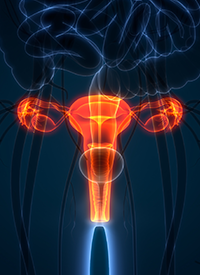Article
VB10.16 Plus Atezolizumab Generates Positive Survival Data in PD-L1+ Advanced Cervical Cancer
Author(s):
The combination of the potentially first-in-class off-the-shelf therapeutic cancer vaccine candidate VB10.16 and atezolizumab elicited a median overall survival greater than 25 months in patients with PD-L1–positive, human papillomavirus 16–positive advanced cervical cancer.
Image Credit: © magicmine - stock.adobe.com

The combination of the potentially first-in-class off-the-shelf therapeutic cancer vaccine candidate VB10.16 and atezolizumab (Tecentriq) elicited a median overall survival (OS) greater than 25 months in patients with PD-L1–positive, human papillomavirus 16 (HPV16)–positive advanced cervical cancer, according to final data from the phase 2 VB-C-02 trial (NCT04405349).1,2
The median OS was not yet reached (NR) in the PD-L1–positive population (n = 24), and the median progression-free survival (PFS) was 6.3 months (95% CI, 3.6-16.9).
The overall population (n = 47) achieved a median OS of 16.9 months (95% CI, 8.3-NR) and a median PFS of 4.1 months (95% CI, 2.1-6.2).
“We are extremely encouraged by the unprecedented data that indicates a doubling of the survival of PD-L1–positive patients with advanced cervical cancer compared [with] treatment alternatives. Not only do we see patients on average live longer, but 7 of the 14 patients who received all treatments are still alive without signs of progression,” Michael Engsig, chief executive officer of Nykode Therapeutics, stated in a news release.1 “This is a landmark day for VB10.16 and for Nykode’s technology, and we are excited to move the cancer vaccine forward towards the market for the benefit of patients.”
“The data give us confidence as we now plan to initiate a potentially registrational trial in the U.S. during the fourth quarter [of 2023] in advanced cervical cancer and work to accelerate expansion of our VB10.16 program with the goal of reaching all addressable patient populations with HPV16-positive cancers,” added Klaus Edvardsen, chief development officer of Nykode.
VB10.16 is an off-the-shelf vaccine targeting the cancer-specific, full-length HPV16 E7 and E6 antigens.2 Previous data from the phase 2 study showed that VB10.16 plus atezolizumab produced responses in heavily pretreated patients with HPV16-positive cervical cancer.3
The multicenter, single-arm, open-label VB C-02 trial enrolled patients with advanced or recurrent, unresectable HPV16-positive cervical cancer. Patients received 3 mg of VB10.16 once every 3 weeks for 5 cycles during induction, followed by once every 6 weeks for 6 cycles during maintenance. Atezolizumab was administered at 1200 mg once every 3 weeks. Treatment with the combination lasted for up to 48 weeks, and follow-up continued for 12 months thereafter.
The incidence and severity of adverse effects (AEs), as well as overall response rate (ORR) as per RECIST v1.1 criteria assessed by blinded independent central review, served as the trial’s primary end points. Secondary end points included duration of response (DOR), PFS, OS, and immunogenicity.
Among the overall population evaluable for safety (n = 52), the median age was 47.5 years (range, 27-83). The majority of patients had squamous cell carcinoma (81%), followed by adenocarcinoma (15%), adenosquamous carcinoma (2%), and unknown (2%). Four percent of patients received no prior lines of systemic therapy, 50% had 1 prior line of therapy, and 46% had at least 2 prior lines of therapy. Fifty-six percent of patients had an ECOG performance status of 0, and 44% had an ECOG performance status of 1.
Forty-eight percent of patients were PD-L1 positive, 39% were PD-L1 negative, and 14% had an unknown PD-L1 status.
Additional data showed that in the PD-L1–positive population, the ORR was 29% (95% CI, 13%-51%), including a complete response (CR) rate of 8% (95% CI, 1%-27%). The disease control rate (DCR) was 75% (95% CI, 53%-90%). Minimal response (MR) consisting of stable disease with tumor shrinkage of at least 10% and less than 30% was observed in 17% (95% CI, 5%-37%) of patients. The median DOR was 17.1 months (95% CI, 2.2-NR).
Among the overall population, the ORR was 19% (95% CI, 9%-33%) with a CR rate of 6% (95% CI, 1%-18%) and an MR rate of 19% (95% CI, 9%-33%). The DCR was 60% (95% CI, 44%-74%), and the median DOR was 17.1 months (95% CI, 2.6-NR).
The median OS and PFS in the PD-L1–negative population were 7.3 months and 2.8 months, respectively.
Treatment-related AEs (TRAEs) related to either VB10.16 or atezolizumab occurred in 67% of patients, and most were grade 1/2. Ten percent of patients had grade 3 TRAEs related to atezolizumab.
Additionally, 31% of patients had grade 1/2 TRAEs related to VB10.16, and 1 patient (2%) had grade 3 arthralgia related to the vaccine. The most common grade 1/2 TRAEs linked to VB10.16 included administration site pain (4%), fatigue (2%), injection site bruising (4%), injection site discomfort (6%), injection site hematoma (2%), injection site pain (4%), infusion-related reaction (2%), decreased appetite (2%), myalgia (4%), erythema (2%), pruritus (4%), and rash (4%).
No serious AEs related to VB10.16 were reported, and no deaths were related to either VB10.16 or atezolizumab.
References
- Nykode Therapeutics announces positive final results from its phase 2 trial of VB10.16 in combination with PD-L1 inhibitor atezolizumab in advanced cervical cancer. News release. Nykode Therapeutics. April 18, 2023. Accessed April 20, 2023. https://nykode.com/wp-content/uploads/2023/04/230418-Nykode-VB10.16-Data-Update-PR-FINAL.pdf
- VB10.16 final phase 2 data readout – 12 month treatment follow up. Nykode Therapeutics. April 19, 2023. Accessed April 20, 2023. https://nykode.com/wp-content/uploads/2023/04/230419-C-02-data-WEBCAST-Presentation-FINAL.pdf
- Nykode Therapeutics announces positive interim results from its phase 2 trial with VB10.16 in combination with immune checkpoint inhibitor atezolizumab in advanced cervical cancer. News release. Nykode Therapeutics. May 9, 2022. Accessed April 20, 2023. https://nykode.com/wp-content/uploads/2022/05/220509_Nykode-VB-C-02-readout-FINAL.pdf









